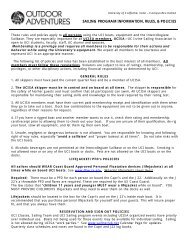J22 Manual - UCI Campus Recreation
J22 Manual - UCI Campus Recreation
J22 Manual - UCI Campus Recreation
Create successful ePaper yourself
Turn your PDF publications into a flip-book with our unique Google optimized e-Paper software.
<strong>UCI</strong> J/22 Sailing <strong>Manual</strong> 40<br />
sure it is long enough to reach the other boat. It may be necessary to tie your bow and stern<br />
lines together to make a longer towline. Tie the towline around the mast with a bowline and<br />
lead it through one of the bow pad-eyes for all tows in the ocean and multi-boat tows. If you<br />
are only being towed in the bay for a short distance, you may use the bow pad-eye to secure<br />
the tow-line. While undertow, steer a straight course behind the other boat. Always drop your<br />
jib while being towed; you may decide to leave the main up while under tow (a good idea if it is<br />
dark), but be sure you do not sail into the boat ahead. Always leave ample distance between<br />
the boats, especially when in rough seas, and never get your body, hands or feet between the<br />
two boats. Never try to hold onto a towline with your hands. When a line is thrown to you,<br />
immediately secure it. When you are being towed for a longer distance, carefully inspect the<br />
line, making sure that it is not chafing through. If a tow line snaps, it can be very dangerous and<br />
it may injure someone as it flings about.<br />
Becalmed<br />
If you are caught without wind, particularly towards dark in the ocean, it is likely that you will<br />
have to pick up a tow to make it back to the harbor. Without a tow the boat can only get<br />
forward momentum from paddling. Sculling is difficult for anything but very short distances in a<br />
J/22. In the bay, tides will have a strong effect on you. If the tide is incoming, this will help you<br />
make it back to the base, Out in the ocean the prevailing current runs down the coast.<br />
Therefore, if you are west of the jetty, the current will help carry you home. You may still need<br />
to paddle and look for a tow. Never get too close to shore, especially in light air. You may not<br />
be able to get back out again. This also applies to the jetty. If you are becalmed east of the jetty,<br />
your condition is more serious. The current will carry you farther south or into the rocks or kelp<br />
beds onshore. In this case, if you are losing headway, anchor. Leave your sails up after dark so<br />
that a passing boat can more easily see you. Signal a passing boat, using one of the signal flares<br />
if necessary. Do NOT swim to shore or abandon the boat. As you progress and sail on your own<br />
you MUST learn to recognize the wind patterns and avoid being caught with no wind, especially<br />
out in the ocean. In class, always stay in sight of your instructor and the other J/22 keelboats.<br />
Your instructor can assist in towing boats back to the base if the wind dies.<br />
Fog<br />
Just a short word regarding fog is appropriate here. If you are outside the harbor and a fog bank<br />
is quickly moving in, take a bearing on the west jetty with the compass of your smart phone,<br />
then sail at that heading to return home, being careful to avoid the jetty and other known<br />
hazards. It is also important to take into account the effect the current will have on you,<br />
especially in very light air. There are fog signals that should be used by all boats when<br />
maneuvering in dense fog. These signals should be memorized and used when needed in low<br />
visibility weather. These fog signals are listed below.<br />
Sailing vessels underway should sound, at intervals of not more than two minutes: A<br />
prolonged blast (5 seconds), followed by 2 short blasts (1 second each).<br />
Unencumbered power vessels underway shall sound, at intervals of not more than<br />
two minutes: A prolonged blast (5 seconds).<br />
Other horn signals you should be aware of: power vessel leaving a dock or getting underway







